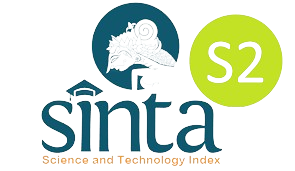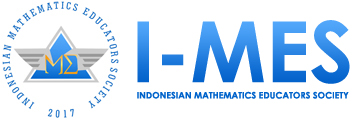Representasi Matematis dalam Pembelajaran dengan Model Problem-Based Learning Berbasis Etnomatematika Ditinjau dari Tipe Kepribadian
DOI:
https://doi.org/10.29408/jel.v5i2.1325Keywords:
ethnomathematics, mathematical representation, problem-based learning, personality typeAbstract
This research aims to describe the ability of students' mathematical representation in learning with ethnomatematics-based PBL models which is reviewed from personality type topology of Hippocrates and Galenus. This research is a qualitative descriptive reasearch. The subject of this reaserch is the fourth semester students of mathematics education study program. Subject collection using purposive sampling technique. Data collection techniques in this reaserch are observation, questionnaires, interviews, and documentation. Data validity uses triangulation.The data analysis technique uses the Miles and Huberman model, namely data reduction, data presentation, drawing conclusions, and verifying conclusions. The results of this reaserchisthe choleric personality type does not fulfillthe first indicator is cannot use representation to model and interpret physical, social, and mathematical phenomena. Melancholy and phlegmatic personality typefulfill all indicators. Whereas the poetic type does not fulfill the third indicator, that is, it cannot choose, apply and translate between mathematical representations to solve problems.
References
Agustina, R., Sujadi, I., & Pangadi. (2013). Proses berpikir siswa SMA dalam penyelesaian masalah aplikasi turunan fungsi ditinjau dari tipe kepribadian tipologi Hippocrates-Galenus. Jurnal Pembelajaran Matematik. 1(4). https://doi.org/10.24127/ajpm.v3i1.381.
Amalia, S.R & Widodo, A.N.A. (2018). Analisis kemampuan pemecahan masalah mahasiswa melalui model PBL berbasis etnomatematika ditinjau dari kepribadian topologi hippocrates, galenus tipe cholearis dan phlegmantis. Aksioma: 9(1), 1-10. http://dx.doi.org/10.26877/aks.v9i1.2467.
Amalia, S.R & Widodo, A.N.A. (2019). Analisis kemampuan pemecahan masalah melalui model PBL berbasis etnomatematika ditinjau dari tipe kepribadian sanguinis dan melankholis. PRISMA, 2, 156-160. Diambil dari https://journal.unnes.ac.id/sju/index.php/prisma/article/view/28903/12635.
Arikunto, S. (2012). Prosedur penelitian suatu pendekatan praktek. Jakarta: Rineka Cipta.
Bulu, V.R., Budiyono, & Slamet, I. (2015). Kesulitan metakognisi siswa dalam memecahkan masalah matematika pada materi peluang ditinjau dari tipe kepribadian tipologi hippocrates–galenus kelas XI MIA-1 SMA Negeri I Soe. Jurnal Elektronik Pembelajaran Matematika. 3(9), 970-984. Diambil dari https://jurnal.uns.ac.id/jpm/article/view/10800/9676.
Farhan, M., & Retnawati, H. (2014). Keefektifan PBL dan IBL ditinjau dari prestasi belajar, kemampuan representasi matematis, dan motivasi belajar. Jurnal Riset Pendidikan Matematika, 1(2), 227-240. https://doi.org/10.21831/jrpm.v1i2.2678.
Fitria, C., & Siswono, T.Y.E. (2014). Profil keterampilan berpikir kreatif siswa dalam memecahkan masalah matematika ditinjau dari tipe kepribadian (sanguinis, koleris, melankolis, dan phlegmatis). MATHEdunesa. 3(3), 23-32. Diambil dari https://jurnalmahasiswa.unesa.ac.id/index.php/mathedunesa/article/view/12685/11699.
Littauer, F. (2002). Personality plus for parents. Jakarta : Binarupa Aksara.
NCTM. (2003). NCATE/NCTM program standards: programs for initial preparation of mathematics teachers, standards for secondary mathematics teachers. Diambil dari https://www.nctm.org/uploadedFiles/Standards_and_Positions/CAEP_Standards/NCTMSECONStandards.pdf.
Pieter, H.Z. (2017). Dasar-dasar komunikasi bagi perawat. Jakarta: Kencana.
Prihadhi, E. K. (2008). My potency. Jakarta : Gramedia.
Sabirin, M. (2014). Representasi dalam pembelajaran matematika. JPM IAIN Antasari, 1(2), 33-44. https://doi.org/10.18592/jpm.v1i2.49.
Soleh, A. Z. (2005). Ilmu statistik. Bandung: Rekayasa Sains.
Sumartini, T. S. (2016). Peningkatan kemampuan pemecahan masalah matematis siswa melalui pembelajaran berbasis masalah. Mosharafa, 5(2). https://doi.org/10.31980/mosharafa.v5i2.270.
Tan, O. S. (2003). Problem based learning innovation: using problem to power learning in the 21st century. Asia: Cengage Learning.
Tan, T. (2017). Theaching is an art: maximize your teaching. Yogyakarta: CV. Budi Utama.
Ulya, H., & Rahayu, R. (2018). Uji kelayakan perangkat pembelajaran open-ended berbasis etnomatematika ditinjau dari gaya kognitif siswa. Journal of Medives: Journal of Mathematics Education IKIP Veteran Semarang, 2(2), 183-194. https://doi.org/10.31331/medives.v2i2.645.
Downloads
Additional Files
Published
How to Cite
Issue
Section
License
Authors who publish with the Jurnal Elemen agree to the following terms:
- Authors retain copyright and grant the journal right of first publication with the work simultaneously licensed under Creative Commons Attribution-ShareAlike 4.0 International License (CC BY-SA 4.0).
- Authors are able to enter into separate, additional contractual arrangements for the distribution of the journal's published version of the work (e.g., post it to an institutional repository or publish it in a book), with an acknowledgment of its initial publication in this journal.
- Authors are permitted and encouraged to post their work online (e.g., in institutional repositories or on their website) prior to and during the submission process, as it can lead to productive exchanges, as well as earlier and greater citation of published work.
Jurnal Elemen is licensed under a Creative Commons Attribution-ShareAlike 4.0 International License





